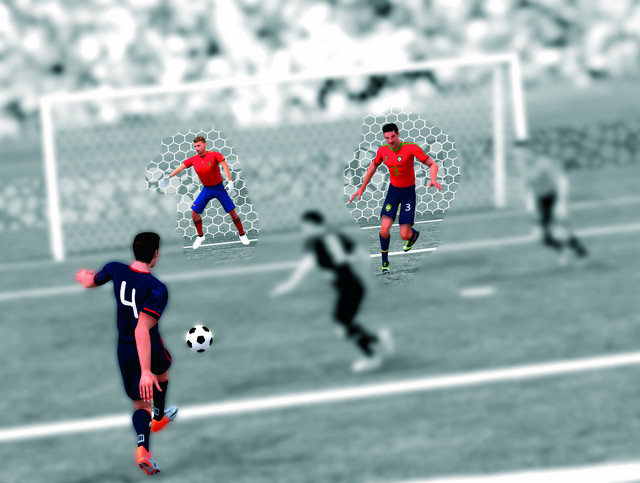Dual spotlights in the brain
The "tiki-taka"-style of the Spanish national football team is amazing to watch: Xavi passes to Andrès Iniesta, he just rebounds the ball once and it's right at Xabi Alonso's foot. The Spanish midfielders cross the field as if they run on rails, always maintaining attention on the ball and the teammates, the opponents chasing after them without a chance. An international team of scientists from the German Primate Center and McGill University in Canada, including Stefan Treue, head of the Cognitive Neuroscience Laboratory, has now uncovered how the human brain makes such excellence possible by dividing visual attention: The brain is capable of splitting its 'attentional spotlight' for an enhanced processing of multiple visual objects. (Neuron, doi: 10.1016/j.neuron.2011.10.013)
When we pay attention to an object, neurons responsible for this location in our field of view are more active then when they process unattended objects. But quite often we want to pay attention to multiple objects in different spatial positions, with interspersed irrelevant objects. Different theories have been proposed to account for this ability. One is, that the attentive focus is split spatially, excluding objects between the attentional spotlights. Another possibility is, that the attentional focus is zoomed out to cover all relevant objects, but including the interspersed irrelevant ones. A third possibility would be a single focus rapidly switching between the attended objects.
Studying rhesus macaques
In order to explain how such a complex ability is achieved, the neuroscientists measured the activity of individual neurons in areas of the brain involved in vision. They studied two rhesus macaques, which were trained in a visual attention task. The monkeys had learned to pay attention to two relevant objects on a screen, with an irrelevant object between them. The experiment showed, that the macaques' neurons responded strongly to the two attended objects with only a weak response to the irrelevant stimulus in the middle. So the brain is able to spatially split visual attention and ignore the areas in between. "Our results show the enormous adaptiveness of the brain, which enables us to deal effectively with many different situations.
This multi-tasking allows us to simultaneously attend multiple objects", Stefan Treue says. Such a powerful ability of our attentive system is one precondition for humans to become perfect football-artists but also to safely navigate in everyday traffic.
Original Publication
Robert Niebergall, Paul S. Khayat, Stefan Treue, Julio C. Martinez-Trujillo (2011): Multifocal attention filters out targets from distractors within and beyond primate MT neurons receptive field boundaries. Neuron, Volume 72, Issue 6, 1067-1079, 22 December 2011. doi: 10.1016/j.neuron.2011.10.01
Contact
Prof. Dr. Stefan Treue
Phone: +49 551 3851-117
E-mail: treue(at)gwdg.de
Susanne Diederich (Public Relations Department)
Phone: +49 551 3851-359
E-mail: sdiederich(at)dpz.eu
In case of publication, please send a copy or a link as reference.


